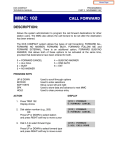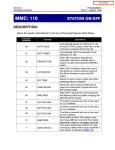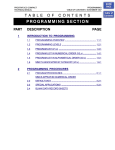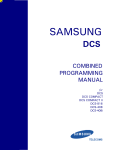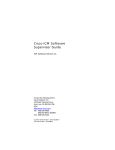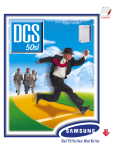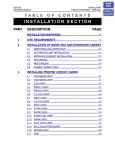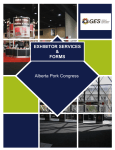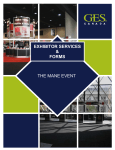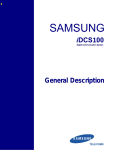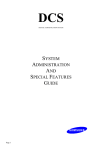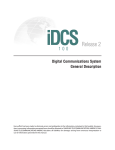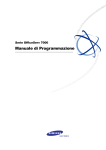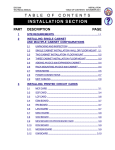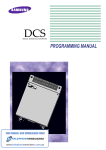Download Manual Update - DCS 50si MMCs
Transcript
DCS 50si TECHNICAL MANUAL MMC: 110 PROGRAMMING PART 2 NOVEMBER 2000 KEYSET ON/OFF DESCRIPTION: Allows the system administrator to set any of the keyset features listed below. 0. AME BGM This feature selects whether a station using Answer Machine Emulation will hear their personal greeting or BGM while callers are listening to the personal greeting. A BGM source must be selected for this to work with CADENCE or the SVMi-4 card. 1. AME PSWD If this option is set to YES, station users who have AME set must enter their station password to listen to messages being left. 2. AUTO HOLD Automatically places an existing C.O. call on hold if a CALL button, trunk key or trunk route key is pressed during that call. 3. AUTO TIMER Automatically starts the stopwatch timer during a C.O. call. 4. HEADSET USE When on, this feature disables the hook switch allowing a headset user to answer all calls by pressing the ANS/RLS button. 5. HOT KEYPAD When on, this feature allows the user to dial directory numbers without having to first lift the handset or press the SPK button. 6. KEY TONE Allows the user to hear a slight tone when pressing buttons on their set. 7. PAGE REJOIN Allows the user to hear the latter part of page announcements if his keyset becomes free during a page. 8. RING PREF. When off, requires the user to press the fast flashing button to answer a ringing call after lifting the handset. PROGRAM KEYS UP & DOWN KEYPAD SOFT KEYS Used to scroll through options Used to enter selections Move cursor left and right DCS 50si TECHNICAL MANUAL PROGRAMMING PART 2 NOVEMBER 2000 MMC: 110 SPK HOLD ANS/RLS Used to store data and advance to next MMC Used to clear previous entry Used to select ALL ACTION DISPLAY 1. Press TRSF 110 Display shows [201] STN ON/OFF AUTO HOLD :OFF 2. Dial keyset number (e.g., 205) OR Press UP or DOWN to select keyset and press RIGHT soft key to move cursor OR Press ANS/RLS for All [205] STN ON/OFF AUTO HOLD :OFF 3. Dial option number from above list (0–5, e.g., 3) OR Press UP or DOWN to select option and press RIGHT soft key to move cursor [205] STN ON/OFF AUTO HOLD :OFF 4. Press UP or DOWN to select ON or OFF and press left or RIGHT soft key to return to step 3 above OR Dial 1 for ON or 0 for OFF [205] STN ON/OFF HOT KEYPAD :OFF [ALL] STN ON/OFF AUTO HOLD :? [205] STN ON/OFF HOT KEYPAD : ON 5. Press TRSF to store and exit OR Press SPK to store and advance to next MMC Dial option number 0 from above list at step 3 [205] STN ON/OFF AUTO HOLD :OFF Dial option number 1 from above list at step 3 [201] STN ON/OFF AUTO TIMER :ON Dial option number 2 from above list at step 3 [205] STN ON/OFF HEADSET :OFF Dial option number 3 from above list at step 3 [205] STN ON/OFF HOT KEYPAD: ON DCS 50si TECHNICAL MANUAL PROGRAMMING PART 2 NOVEMBER 2000 MMC: 110 Dial option number 4 from above list at step 3 [205] STN ON/OFF KEY TONE :ON Dial option number 5 from above list at step 3 [205] STN ON/OFF PAGE REJOIN:ON Dial option number 6 from above list at step 3 [205] STN ON/OFF RING PREF. :ON DEFAULT DATA: AME BGM OFF AUTO HOLD OFF AUTO TIMER ON HEADSET OFF HOT KEYPAD ON KEY TONE ON PAGE REJOIN ON RING PREFERENCE ON RELATED ITEMS: MMC 301 ASSIGN STATION COS MMC 701 ASSIGN COS CONTENTS CADENCE AME FEATURE DCS 50si TECHNICAL MANUAL MMC: 207 PROGRAMMING PART 2 NOVEMBER 2000 ASSIGN VM/AA PORT DESCRIPTION: Allows technician to change a “NORMAL” SLI ports to a VMAA port. VMAA ports will receive inband signalling digits designated in MMC 726 (VM/AA Options) and will also receive a true disconnect signal upon completion of a call. Only SLI boards, not KDb-SLI, support disconnect signal. Do not set VMAA ports as “data ring” (MMC 208). This will delete inband signalling for voice mail integration. VMAA ports have the equivalent of data secure written in the program and are always protected against tones. NOTE: This MMC is not used to assign CADENCE or SVMi-4 voice mail card ports. Voice mail card ports are assigned as voice mail ports automatically when the DCS detects a CADENCE or SVMi-4 card. PROGRAM KEYS UP & DOWN KEYPAD SOFT KEYS SPK HOLD ANS/RLS Used to scroll through options Used to enter selections Move cursor left and right Used to store data and advance to next MMC Used to clear previous entry Used to select ALL ACTION DISPLAY 1. Press TRSF 207 Display shows [209] VMAA PORT NORMAL PORT 2. Dial station number (e.g., 205) OR Press UP or DOWN to select station and press RIGHT soft key to move cursor [205] VMAA PORT NORMAL PORT 3. Dial 1 or 0 to select port type (1 = VMAA and 0 = NORMAL) OR Press UP or DOWN to select option Press RIGHT soft key [209] VMAA PORT VMAA PORT DCS 50si TECHNICAL MANUAL PROGRAMMING PART 2 NOVEMBER 2000 MMC: 207 4. Press TRSF to store and exit OR Press SPK to store and advance to next MMC DEFAULT DATA: NORMAL PORT RELATED ITEMS: MMC 726 VM/AA OPTIONS CADENCE CVM8A CARD SVMi-4 CARD DCS 50si TECHNICAL MANUAL PROGRAMMING PART 2 NOVEMBER 2000 MMC: 308 ASSIGN BACKGROUND MUSIC SOURCE DESCRIPTION: Assigns a background music source to the DCS 50si keysets. There are a total of 5 possible music selections (see below). One music connection is provided on the KSU motherboard. This source can be switched between internal music source (chimes) or an external source. A second external source is provided with the addition of a SMISC card. You may also select an Auto Attendant (AA) port to provide continuous play of a specific recording. The AA port selected must be the last port on the SMISC2 card. If selected, the Music on Hold will be the message defined in MMC 736 from the port defined in this MMC. If you have a CADENCE or SVMi-4 Voice Mail System installed you may also select a voice mail recording as a music source. The recording must already been defined in MMC 748 and will show up here as the voice mail port associated with the recording. OPTIONS 1. NONE: No Background Music. 2. INTERNAL CHIME “OLD FOLKS AT HOME”: This is entered as the directory number of the music source on the KSU motherboard (3701). 3. EXTERNAL DEVICE: Music Source or Digital announcer. This is entered as the directory number of an external music source located on the KSU motherboard (3701) or a SMISC card (3702). 4. DIGITAL ANNOUNCEMENT ON SMISC2 CARD: This is entered as the directory number of the last AA port of an SMISC2 card (3954). 5. VOICE MAIL SOUND FILE: If the 50si system has an optional CADENCE or SVMi-4 card installed, up to 100 custom recorded sound files from the Voice Mail card can be used for BGM sources. Select the voice mail port assigned in MMC748. For information on creating the sound files see CADENCE/SVMi-4 System Administrator Manual-Recording greetings by number. If you select this option be advised that VMMOH source requires one dedicated voice mail port/channel. DCS 50si TECHNICAL MANUAL PROGRAMMING PART 2 NOVEMBER 2000 MMC: 308 PROGRAM KEYS UP & DOWN KEYPAD SOFT KEYS SPEAKER HOLD ANS/RLS Used to scroll through options Used to enter selections Move cursor left and right Used to store data and advance to next MMC Used to clear previous entry Used to select ALL ACTION DISPLAY 1. Press TRSF 308 Display shows current setting [201 ] BGM SOURCE BGM SOURCE:NONE 2. Dial keyset number (e.g., 205) OR Use UP or DOWN to scroll through keyset numbers; press RIGHT soft key to move cursor OR Press ANS/RLS to select all stations [205 ] BGM SOURCE BGM SOURCE:NONE 3. Enter source number (e.g., 3701) OR Press UP or DOWN key to make selection and press RIGHT soft key to return to step 2 [205 ] BGM SOURCE BGM SOURCE:3701 4. Press TRSF to store and exit OR Press SPK to store and advance to next MMC [ALL] BGM SOURCE BGM SOURCE:? DEFAULT DATA: NONE RELATED ITEMS: MMC 309 ASSIGN STATION MUSIC ON HOLD MMC 408 ASSIGN TRUNK MUSIC ON HOLD SOURCE AUTO ATTENDANT PROGRAMMING MMC 748 ASSIGN VMMOH DCS 50si TECHNICAL MANUAL MMC: 309 PROGRAMMING PART 2 NOVEMBER 2000 ASSIGN STATION MUSIC ON HOLD DESCRIPTION: This MMC is used to select what MOH source you will hear when another internal station puts you on hold. There are a total of 5 possible music selections (see below). One music connection is provided on the KSU motherboard. This source can be switched between internal music source (chimes) or an external source. A second external source is provided with the addition of a SMISC card. In addition to “TONE” or a music source, you may also select an Auto Attendant (AA) port to provide continuous play of a specific recording. The AA port selected must be the last port on the card. If selected, the Music on Hold will be the message defined in MMC 736 from the port defined in this MMC. If you have a CADENCE or SVMi-4 Voice Mail System installed you may also select a voice mail recording as a music source. The recording must already been defined in MMC 748 and will show up here as the voice mail port associated with the recording. OPTIONS 1. NONE: No Music on Hold. 2. TONE: A repeated tone is played to the holding party. 3. INTERNAL CHIME “OLD FOLKS AT HOME”: This is entered as the directory number of the music source on the KSU motherboard (3701). 4. EXTERNAL DEVICE: Music Source or Digital announcer. This is entered as the directory number of an external music source located on the KSU motherboard (3701) or a SMISC card (3702). 5. DIGITAL ANNOUNCEMENT ON SMISC2 CARD: This is entered as the directory number of the last AA port of an SMISC2 card. 6. VOICE MAIL SOUND FILE: If the 50si system has an optional CADENCE or SVMi-4 card installed, up to 100 custom recorded sound files from the Voice Mail card can be used for MOH sources. Select the voice mail port assigned in MMC 748. For information on creating the sound files see CADENCE / SVMi-4 System Administrator Manual-Recording greeting by number. If you select this option be advised that each VMMOH source requires one dedicated voice mail port/channel. DCS 50si TECHNICAL MANUAL PROGRAMMING PART 2 NOVEMBER 2000 MMC: 309 PROGRAM KEYS UP & DOWN KEYPAD SOFT KEYS SPK HOLD ANS/RLS Used to scroll through options Used to enter selections Move cursor left and right Used to store data and advance to next MMC Used to clear previous entry Used to select ALL ACTION DISPLAY 1. Press TRSF 309 Display shows current setting [201 ] MOH SOURCE MOH SOURCE:NONE 2. Dial keyset number (e.g., 205) OR Use UP or DOWN to scroll through keysets Press RIGHT soft key to move the cursor OR Press ANS/RLS to select all stations [205 ] MOH SOURCE MOH SOURCE:NONE 3. Enter source number (e.g., 3701) OR Press UP or DOWN key to make selection Press RIGHT soft key to return to step 2 [205 ] MOH SOURCE MOH SOURCE:3701 [ALL] MOH SOURCE MOH SOURCE:? 4. Press TRSF to store and exit OR Press SPK to store and advance to next MMC DEFAULT DATA: NONE RELATED ITEMS: MMC 308 ASSIGN BACKGROUND MUSIC SOURCE MMC 408 ASSIGN TRUNK MUSIC ON HOLD SOURCE MMC 748 ASSIGN VMMOH DCS 50si TECHNICAL MANUAL MMC: 408 PROGRAMMING PART 2 NOVEMBER 2000 ASSIGN TRUNK MUSIC ON HOLD SOURCE DESCRIPTION: Allows the System Administrator to select what a trunk caller will hear when that trunk is placed on hold. There are a total of 5 possible music selections (see below). In addition to “TONE” or a music source, you may also select an Auto Attendant (AA) port to provide continuous play of a specific recording. The AA port selected must be the last AA port on the SMISC2 card (3954). If selected, the Music on Hold will be the message defined in MMC 736 from the port defined in this MMC. If you have a CADENCE or SVMi-4 Voice Mail System installed you may also select a voice mail recording as a music source. The recording must already been defined in MMC 748 and will show up here as the voice mail port associated with the recording. OPTIONS 1. NONE: No Music on Hold. 2. TONE: A repeated tone is played to the outside party. 3. INTERNAL CHIME “OLD FOLKS AT HOME”: This is entered as the directory number of the music source on the KSU motherboard (3701). 4. EXTERNAL DEVICE: Music Source or Digital announcer. This is entered as the directory number of an external music source located on the KSU motherboard (3701) or a SMISC card (3702). 5. DIGITAL ANNOUNCEMENT ON AA CARD: This is entered as the directory number of the last AA port of an SMISC2 card. For further details on using an AA port as an MOH source please see MMC 736. 6. VOICE MAIL SOUND FILE: If the 50si system has an optional CADENCE or SVMi-4 card installed, up to 100 custom recorded sound files from the Voice Mail card can be used for MOH sources. Select the voice mail port assigned in MMC 748. For information on creating the sound files see CADENCE / SVMi-4 System Administrator Manual-Recording greeting by number. If you select this option be advised that each VMMOH source requires a dedicated voice mail port/channel. DCS 50si TECHNICAL MANUAL PROGRAMMING PART 2 NOVEMBER 2000 MMC: 408 PROGRAM KEYS UP & DOWN KEYPAD SOFT KEYS SPK HOLD ANS/RLS Used to scroll through options Used to enter selections Move cursor left and right Used to store data and advance to next MMC Used to clear previous entry Used to select ALL ACTION DISPLAY 1. Press TRSF 408 Display shows current setting [701 ] TRK MOH MOH SOURCE:TONE 2. Dial trunk number (e.g., 704) OR Use UP or DOWN to scroll through trunks Press RIGHT soft key to move cursor OR Press ANS/RLS to select ALL [704 ] TRK MOH MOH SOURCE:TONE 3. Enter source number (e.g., 3701) OR Press UP or DOWN key to select option Press RIGHT soft key to return to step 2 above [705 ] TRK MOH MOH SOURCE:3701 [ALL] TRK MOH MOH SOURCE:? 4. Press TRSF to store and exit OR Press SPK to store and advance to next MMC DEFAULT DATA: TONE RELATED ITEMS: MMC 308 ASSIGN BACKGROUND MUSIC SOURCE MMC 748 ASSIGN VMMOH DCS 50si TECHNICAL MANUAL PROGRAMMING PART 2 NOVEMBER 2000 MMC: 501 SYSTEM TIMERS DESCRIPTION: Allows the technician to adjust individual timers as necessary. NOTE: Certain timers are disabled when the value is “000”. PROGRAM KEYS UP & DOWN KEYPAD SOFT KEYS SPK Used to scroll through options Used to enter selections Move cursor left and right Used to store data and advance to next MMC ACTION DISPLAY 1. Press TRSF 501 Display shows first timer value AA INT DGT TIME 05 SEC → 2. Press UP or DOWN key to select timer and press RIGHT soft key to move cursor KMMC LOCK OUT TM 30 SEC → _ 3. Enter new value using keypad; if valid, system returns to step 2 with new value KMMC LOCK OUT TM 30 SEC → 255 4. Press TRSF to store and exit OR Press SPK to store and advance to next MMC DEFAULT DATA: SEE TABLE OF TIMERS AND VALUES RELATED ITEMS: NONE DCS 50si TECHNICAL MANUAL PROGRAMMING PART 2 NOVEMBER 2000 MMC: 501 TIMER TABLE TIMER NAME DEFAULT RANGE AA INT DGT TIME* AA NO ACT TIME* ALERT TONE TIMER ALM REM.INTERVAL ALM REM.RING OFF ATT.RECALL TIME AUTO REDIAL INT. AUTO REDIAL RLS. CADENCE CARD TONE INT TIME CALLBACK NO ANS CAMP ON RECALL CID DISPLAY TIME* CID MSG RECEIVE* CO–CO DISCONNECT CONFIRM TONE TM CRD TONE INT TM DIAL PASS TIME DISA DISCONNECT DISA DTMF DETECT DISA LOCK OUT/TM DISA PASS CHECK DISPLAY DELAY TM DOOR LOCK RELES. DOOR RING DETECT DOOR RING OFF TM E-HOLD RECALL TM EXT.FWD DELAY TM FIRST DIGIT TIME HOK FLASH MAX TM HOK FLASH MIN TM HOOK OFF TIME HOOK ON TIME INQUIRY RELEASE INTER DIGIT TIME KMMC LOCK OUT TM LCR ADVANCE TIME LCR INTER DIGIT OFF HOK RING INT OFF HOOK SELECT OHVA ANSWER TIME OVERLAP INT DGT PAGE TIME OUT PAGE TONE TIME PARK RCALL TIME PC-MMC LOCK OUT 05 SEC 10 SEC 1000 MS 10 SEC 26 SEC 30 SEC 30 SEC 45 SEC 000 SEC 30 SEC 30 SEC 05 SEC 08 SEC 20 MIN 1000 MS 30 SEC 05 SEC 30 MIN 000 SEC 30 MIN 30 MIN 03 SEC 500 MS 50 MS 30 SEC 45 SEC 10 SEC 10 SEC 800 MS 350 MS 200 MS 1000 MS 30 SEC 10 SEC 30 SEC 05 SEC 05 SEC 15 SEC 05 SEC 10 SEC 7 SEC 20 SEC 500 SEC 45 SEC 5 MIN 1–25 SEC 1–25 SEC 100–2500 MS 1–255 SEC 1–25 SEC 1–255 SEC 1–255 SEC 1–255 SEC 001–255 SEC 1–255 SEC 1–255 SEC 1–25 SEC 1–25 SEC 0–255 MIN 100–2500 MS 001–255 SEC 1–25 SEC 1–255 MIN 0-255 SEC 1–255 MIN 1–255 MIN 1–255 SEC 100–2500 MS 10–250 MS 1–255 SEC 0–255 SEC 1–255 SEC 1–255 SEC 0010–2500MS 0010–2500MS 10–250 MS 100–2500 MS 1–255 SEC 10–255 SEC 100–255 SEC 1–255 SEC 1–255 SEC 1–255 SEC 0–255 SEC 1–255 SEC 1–15 SEC 1–255 SEC 100–2500 0–255 SEC 5–60 MIN DCS 50si TECHNICAL MANUAL PROGRAMMING PART 2 NOVEMBER 2000 MMC: 501 TIMER NAME POWER DOWN TIME RECALL DISCONECT RECALL WAIT TIME SMDR START/DP SMDR START/DTMF SYS HOLD RECALL TRANSFER RECALL UCDS AUDIO ALARM* UCDS VISUAL ALAM* DEFAULT RANGE 2000 MS 45 MIN 15 SEC 30 SEC 15 SEC 45 SEC 15 SEC 0 SEC 0 SEC 1000–9000 MS 1–255 SEC 1–255 SEC 1–255 SEC 1–255 SEC 0–255 SEC 0–255 SEC 0–255 SEC 0–255 SEC NOTE: Timers marked with an asterisk require optional hardware and/or software. TIMER DESCRIPTIONS AA INT DGT TIME When the AA card is installed, this timer determines the interdigit time for AA call processing. If this timer expires before valid digits are received by the AA card, the call will be routed to the AA invalid digits destination. AA NO ACT TIME When the AA card is installed, this timer determines the time that the AA card will wait for a first digit for AA call processing. If this timer expires before a digit is received, the call will be routed to the AA no action destination. ALERT TONE TIMER This timer sets the duration of the attention tone preceding a call to a keyset in the Voice Announce or Auto Answer mode. This tone will also precede a forced Auto Answer call. ALM REM INTERVAL This timer controls the time length between ring attempts at a station when alarm reminder is set. ALM REM RING OFF This timer controls the length of the ring cycle duration when alarm reminder is set at a station. ATT RECALL TIME This is the length of time a transfer recall will ring at a station before recalling the operator. AUTO REDIAL INT This timer controls the time between attempts after RETRY dialing is set on a station. AUTO REDIAL RLS This timer controls the duration of a Ring No Answer condition on a retry number dialed before the auto redial is automatically canceled. DCS 50si TECHNICAL MANUAL PROGRAMMING PART 2 NOVEMBER 2000 MMC: 501 CALLBACK NO ANS This timer controls the time before the callback is automatically canceled when a callback detects Ring No Answer. CADENCE CARD TONE INT TIME This is the call record tone interval time. An entry other than zero will cause a tone to be heard by all the parties in a recorded conversation. The range for the tone is 001 (every second) to 255 (every 255 seconds). A value of 000 means no tone. CAMP ON RECALL This timer controls the duration of time a camped-on call will stay at a destination before recalling to the transferring station. CID DISPLAY TIME The amount of time that the Caller ID information remains on the keyset’s display. CID MSG RECEIVE The amount of time that the system will allow a valid message from the C.O. C.O.-C.O. DISCONNECT This timer monitors the duration of a unsupervised conference; when it expires, both trunks are disconnected. CONFIRM TONE TIME The tone heard when a feature is activated or deactivated. CRD TONE INT TM This is the call record tone interval time. An entry other than zero will cause a tone to be heard by all the parties in a recorded conversation. The range for the tone is 001 (every second) to 255 (every 255 seconds). A value of 000 means no tone. Requires CADENCE CVM8A card. DIAL PASS TIME This timer monitors the duration of the time before connecting the transmit of an analog station port to the trunk side of an outgoing call. DISA DTMF DETECT This timer sets the time duration that DTMF can be received on a DISA line. DISA DISCONNECT This timer controls the maximum duration of a DISA call. DISA LOCK OUT TIMER This timer controls the duration of time a DISA call is not allowed to be made after the DISA error counter has expired (MMC 500). DISA PASS CHECK This timer defines the time period before the system clears the incorrect passcode counter. DCS 50si TECHNICAL MANUAL PROGRAMMING PART 2 NOVEMBER 2000 MMC: 501 DISPLAY DELAY TIMER This timer controls the duration a display is shown in the LCD display. This timer also controls the duration of time that error tone is heard. DOOR LOCK RELEASE This timer controls the duration of time the door lock relay will be activated. DOOR RING DETECT This timer controls the duration of time before a call is answered by the door phone. DOOR RING OFF TM This timer controls the duration of ringing at the door ring destination before automatically canceling. E-HOLD RECALL TM This timer controls the duration of time a call is held exclusively at a station before recalling. EXT. FWD DELAY TM This timer controls the External Call Forward feature which will allow a station to ring before the call is placed on external call forwarding. FIRST DIGIT TIME This timer controls how long the system will wait for dialing to begin before dropping the dial tone and returning the user to error tone. HOK FLASH MAX TM This timer monitors the duration of a hookswitch flash to ensure that the flash is valid and not a line noise or an accidental hookswitch bounce (LONGEST DURATION). HOK FLASH MIN TM This timer monitors the duration of a hookswitch flash to ensure that the flash is valid and not a line noise or an accidental hookswitch bounce (SHORTEST DURATION). HOOK OFF TIME This timer controls the time before dial tone is sent to a single line station. HOOK ON TIME This timer sets the minimum amount of time that the system will recognize as an SLT hang up. INQUIRY RELEASE This timer monitors the duration of the interaction of the soft key to determine when to return the LCD back to a normal status. This timer affects only display phones. INTER DIGIT TIME This timer controls the grace period between dialing valid digits before dropping the call and returning the user back to error tone. DCS 50si TECHNICAL MANUAL PROGRAMMING PART 2 NOVEMBER 2000 MMC: 501 KMMC DIGIT TIME This timer controls the grace period between programming actions while in a programming session. The timer automatically returns the system to secure programming status. LCR ADVANCE TIME This timer controls the duration of time before selecting the next allowable route when a station is allowed to route advance. LCR INTER DIGIT This timer controls the grace period between dialing valid digits before dropping the call and returning the user back to error tone. OFF HOOK RING This timer controls the duration of time between ring bursts to a user who has a camped-on call. OFF HOOK SELECT This timer controls the grace period before placing a internal/external call as programmed in MMCs 306 and 307. OHVA ANSWER TIME This timer controls the time duration of an OHVA call before automatic rejection. OVERLAP INT DGT This timer controls the amount of time the system will wait for further digits to be dialed before selecting a BRI channel when the BRI’s are defined as OVERLAP mode. PAGE TIME OUT This timer controls the duration of an external page announcement. PAGE TONE TIME This timer controls the duration of tone burst heard over the page prior to the page announcement. PARK RECALL TIME This timer controls the duration of time a call is parked before recalling to the call park originator. PC-MMC LOCK OUT This timer monitors the PCMMC activity, drops the link if no action is created by PCMMC and returns the system back to secure program status. POWER DOWN TIME This timer monitors the power to the ROM pack to begin shutdown status. RECALL DISCONNECT This is the time an attendant recall will ring before being disconnected. RECALL WAIT TIME This is the time any recall (hold or transfer) continues to recall at your station before it recalls to the operator. DCS 50si TECHNICAL MANUAL PROGRAMMING PART 2 NOVEMBER 2000 MMC: 501 SMDR START/DIAL PULSE (ROTARY) the This grace period timer starts SMDR recording for rotary dialing. This timer also controls the LCD duration timer on the keysets. The duration time displayed and the SMDR time duration will be the same. SMDR START/DTMF This grace period timer starts SMDR recording for touchtone dialing. This timer also controls the LCD duration timer on the keysets. The duration time displayed and the SMDR time duration will be the same. SYS HOLD RECALL This timer determines the time calls can be left on hold before recalling back to the holding station. This is a system-wide timer. Setting timer to 000 will defeat this feature and no recalling will take place. TRANSFER RECALL This timer determines the time transferred calls ring before recalling. This is a system-wide timer. UCDS AUDIO ALARM When an AA card is installed and the digital UCD package enabled, this counter determines the maximum number of seconds a call has been waiting at the UCD group before the UCD group’s SUPV key begins to flash along with an audio alarm. For more UCD alarm conditions, see MMC 500. UCDS VISUAL ALARM When an AA card is installed and the digital UCD package enabled, this counter determines the maximum number of seconds a call at the UCD group before the UCD group’s SUPV key begins to flash as an alarm. For more UCD alarm conditions, see MMC 500. DCS 50si TECHNICAL MANUAL MMC: 601 PROGRAMMING PART 2 NOVEMBER 2000 ASSIGN STATION GROUP DESCRIPTION: This MMC is used to build all station groups except the operator group (for the operator group see MMC 600). The options for setting up these groups are as follows; A thru G. A. TYPE: This is the type of group you are creating and can be one of the following: 1. NORMAL: Used to assign stations in a ring group. The members can be stations, common bell contacts or Ring over Page relays. 2. VMAA: Used to group a number of voice mail port extensions. These must have been defined in MMC 207 as VMAA ports or they cannot be entered here. Check all programming in MMC 726 to ensure that the In band DTMF codes are properly set. 3. AA: This is used to group a number of AA ports. An AA card must be installed in the system to do this. 4. CADENCE: This is the voice mail group for CADENCE / SVMi-4 (the built in Samsung Voice Mail cards). When a voice mail card is installed, group 529 is created as a voice mail group. 5. UCD: Used to build a UCD group. The DCS 50si will support two methods of UCD: • TYPE 1 UCD The group NEXT destination (see below) is defined as an SLT port to which you must connect some type of announcement device to play to callers while they are on hold. Please note that this type of UCD group has the following limitations: a) The announcement device must be able to terminate the announcement with a hook flash and a transfer back to the UCD group. b) Only one caller at a time can hear the announcement. c) Each caller connected to the announcement must hear the announcement in its entirety. DCS 50si TECHNICAL MANUAL PROGRAMMING PART 2 NOVEMBER 2000 MMC: 601 d) It is possible that a new caller may “jump ahead” in the queue if a previous caller is currently connected to the announcement device. • TYPE 2 UCD The group NEXT destination (see below) is defined as an AA port or group. This will only work if an SMISC 2 card has been installed in the DCS. The digital announcer in the SMISC 2 card will supply two recorded announcements to callers in queue. The first announcement is played only once, the second announcement will repeat for as long as the caller is in queue. This type of UCD group has the following advantages: a) No external device need be installed to provide an announcement. b) Multiple callers can hear the announcement(s) simultaneously. c) Callers hearing the announcement will be transferred to a free UCD group member (agent) as soon as the agent becomes available. d) The callers place in queue is always maintained. Additional programming for this type of UCD group is in MMC 607. There is a maximum of 5 UCD groups available due to availability of system resources. B. RING MODE: Each group can have one of the following ring modes. This will decide how calls are placed to the group. 1. SEQUENTIAL: The stations listed as “members” (see below) will be called on a first available basis. Calls will first go to the first member, if the first member is busy, calls will go to the second member, if the first member is busy, calls will go to the second member etc. This type of group is useful for placing the bulk of the incoming calls to a selected individual, with other members only getting the calls when the first member is busy. 2. DISTRIBUTED: The first call will go to the first member, the second call will go to the second member, the third call will go to the third member. This type of group is useful for evenly distributing the call among all group members. 3. UNCONDITIONAL: Calls are placed to all group members simultaneously. If a group member is busy, the can receive off hook ring if defined in MMC 300. This ring mode option is not available for UCD or VMAA groups. DCS 50si TECHNICAL MANUAL PROGRAMMING PART 2 NOVEMBER 2000 MMC: 601 C. OVERFLOW: This is a timer value that will cause unanswered calls to a group to begin also ringing the NEXT PORT ( see below) after this timer has elapsed. If set to 000, no overflow will take place. D. GRP TRANSFER: This is a timer that will determine how long C.O. calls transferred to the group will ring there before recalling. If set to 000, no recall will take place. E. NEXT PORT: This is the station or group number that callers will also ring at if the OVERFLOW feature has been programmed. The NEXT port can be defined as: 1. COMMON BELL ( DN # 3603 - 3605). 2. RING OVER PAGE ( DN # 3601 - 3605). F. MEMBER: List all members that are to be in the group. Up to 32 members are allowed in each group, but stations can be assigned to multiple station groups. G. WRAP UP: This is only available for UCD groups, and will make a UCD agent unavailable to receive additional UCD calls after hanging up from the last one. This is to allow agents to complete work associated with the previous call before the next call begins ringing. NOTES: When a group is called, or a caller is transferred to a group, ringback is sent to the caller. A busy signal will not be returned even if all group members are busy. Obviously UCD is an exception to this rule. Calls to a group do not follow the call forwarding instructions of any stations in the group. FEATURE KEYS 0 1 2 3 4 5 6 TYPE RING OVERFLOW GRP TRSF WRAP-UP NEXT PORT MEMBER Group type (Normal, VM/AA, UCD, AA) Ring mode (Sequential, distributed or unconditional) Overflow time (000 - 250 secs.) Group transfer time (000 - 250 secs.) Wrap-up time (timer only valid in type = UCD) Overflow port (Any station, common bell or ring over page) Group members (e.g., station 202, 225, 231) DCS 50si TECHNICAL MANUAL PROGRAMMING PART 2 NOVEMBER 2000 MMC: 601 RING MODES 0 SEQUENTIAL The first idle station listed in the group will ring. If the first is busy, the next idle station will ring. 1 DISTRIBUTED The first call will ring the first station listed in the group. The next call will ring the next station listed in the group. 2 UNCONDITIONAL All the stations listed in the group will ring. Busy stations will receive off-hook ring. MAXIMUM 32 STATIONS RINGING. PROGRAM KEYS UP & DOWN KEYPAD SOFT KEYS SPK HOLD Used to scroll through options Used to enter selections Move cursor left and right Used to store data and advance to next MMC Used to clear previous entry ACTION DISPLAY 1. Press TRSF 601 Display shows [501] STN.GROUP TYPE:NORMAL GRP 2. Dial group number (e.g., 505) OR Press UP or DOWN key to select group Press LEFT soft key to move cursor to type of group and DIAL group type (0–2, e.g., 1) OR Press UP or DOWN key to make selection Press LEFT soft key to move cursor to TYPE [505] STN.GROUP TYPE:NORMAL GRP 3. Dial feature option number (0–6, e.g., 0) OR Press UP or DOWN key to make selection Press RIGHT soft key to move cursor to ring value [505] STN GROUP RING:SEQENTIAL [505] STN GROUP TYPE:VMAA DCS 50si TECHNICAL MANUAL PROGRAMMING PART 2 NOVEMBER 2000 MMC: 601 4. Dial ring option (0–2, e.g., 1) OR Press UP or DOWN key to make selection Press LEFT soft key to move cursor back to RING or press RIGHT soft key to return to step 2 [505] STN GROUP RING:DISTRIBUTE 5. Dial next feature option and continue OR Press UP or DOWN key to select option OR Press LEFT soft key to return to step 2 [505] STN GROUP RING:DISTRIBUTE 6. Press TRSF to store and exit OR Press SPK to store and advance to next MMC DEFAULT DATA: NORMAL GROUP RELATED ITEMS: MMC 203 ASSIGN UA DEVICE MMC 204 COMMON BELL CONTROL DCS 50si TECHNICAL MANUAL PROGRAMMING PART 2 NOVEMBER 2000 MMC: 701 ASSIGN COS CONTENTS DESCRIPTION: Similar to MMC 700 but does not allow a copy command. This MMC is primarily used for creating a new class of service. If the unsupervised conference feature is allowed, a programmed CONF key must be available to allow reentry into a conference call. PROGRAM KEYS UP & DOWN KEYPAD SOFT KEYS SPK Used to scroll through options Used to enter selections Move cursor left and right Used to store data and advance to next MMC TOLL LEVEL OPTIONS DIAL DIGIT 0 1 2 3 TOLL LEVEL A B C D DIAL DIGIT 4 5 6 7 ACTION TOLL LEVEL E F G H DISPLAY 1. Press TRSF 701 Display shows COS CONTENTS(01) TOLL LEVEL:A 2. Dial COS (e.g., 06) OR Press UP or DOWN key to select COS Press RIGHT soft key to move cursor to toll level COS CONTENTS(06) TOLL LEVEL:A 3. Dial toll level (e.g., 2—see above list) OR Press UP or DOWN to select new TOLL level OR Press RIGHT soft key to advance to COS options COS CONTENTS(06) TOLL LEVEL:C DCS 50si TECHNICAL MANUAL PROGRAMMING PART 2 NOVEMBER 2000 MMC: 701 4. Dial COS option (e.g., 09—see Caller ID option list or Basic option list) OR Press UP or DOWN key to select option Press RIGHT soft key to move cursor COS CONTENTS(06) 09:DND :YES 5. Dial 0 for NO or 1 for YES OR Press UP or DOWN key to select option Press LEFT soft key to return to step 4 Press RIGHT soft key to return to step 2 COS CONTENTS(06) 09:DND : NO 6. Press F key to enter MMC 700 if copy of COS to another COS is required Refer to MMC 700 for copying COPY COS ITMES COS 01→ →COS 10 7. Press TRSF to store and exit OR Press SPK to store and advance to next MMC Table A. COS Feature List by Option Number Basic 01 02 03 04 — — — 05 06 07 08 09 10 11 12 13 14 15 16 17 18 19 CID 01 02 03 04 05 06 07 08 09 10 11 12 13 14 15 16 17 18 19 20 21 22 LCD Display AA CALER ALM CLR AUTO RDL CALLBACK CID ABND CID INQR CID INVT CONFER DALM CLR DAY/NIGH DIRECT DISA DND DOOR DSS DTS EXT FWD FEATURE FLASH FOLOW-ME FORWARD GRP I/O COS Option Auto answer control by caller* Alarm sensor ring answer Retry on busy Callback Caller ID Abandon* Caller ID Inquire* Caller ID Investigate* Conference DISA alarm ring clear Change day/night mode Directory dial Allow DISA use Do Not Disturb Door ring answer Direct station select Direct trunk select External call forward Feature key Trunk flash Call forward-follow me Forward Group in/out DCS 50si TECHNICAL MANUAL PROGRAMMING PART 2 NOVEMBER 2000 MMC: 701 Table A. COS Feature List by Option Number Basic 20 21 22 23 24 25 26 27 28 29 30 31 32 33 34 35 36 37 38 39 40 41 42 43 44 45 46 47 48 49 50 51 52 53 54 55 56 57 58 59 60 61 CID 23 24 25 26 27 28 29 30 31 32 33 34 35 36 37 38 39 40 41 42 43 44 45 46 47 48 49 50 51 52 53 54 55 56 57 58 59 60 61 62 63 64 LCD Display HOLD HOT LINE INTERCOM MESSAGE MM PAGE NEW CALL OHVAED OHVAING ONEA2 OPERATOR OUT TRSF OVERRIDE PAGE 0 PAGE 1 PAGE 2 PAGE 3 PAGE 4 PAGE 5 PAGE 6 PAGE 7 PAGE 8 PAGE 9 PAGE ✱ PICKUP SECURE SSPD TOL STN LOCK STNGRP 01 STNGRP 02 STNGRP 03 STNGRP 04 STNGRP 05 STNGRP 06 STNGRP 07 STNGRP 08 STNGRP 09 STNGRP 10 STNGRP 11 STNGRP 12 STNGRP 13 STNGRP 14 STNGRP 15 COS Option Hold Hot line Intercom call Message Meet me page New call Ohvaed Ohvaing 1A2 emulation Operator Outgoing transfer Overide Page zone 0 PAGING Page zone 1 PAGING Page zone 2 PAGING Page zone 3 PAGING Page zone 4 PAGING Page zone 5 PAGING Page zone 6 PAGING Page zone 7 PAGING Page zone 8 PAGING Page zone 9 PAGING Page zone ✱ PAGING Call pickup Override secure System speed dial toll check Station locking Station group 01 calling Station group 02 calling Station group 03 calling Station group 04 calling Station group 05 calling Station group 06 calling Station group 07 calling Station group 08 calling Station group 09 calling Station group 10 calling Station group 11 calling Station group 12 calling Station group 13 calling Station group 14 calling Station group 15 callling DCS 50si TECHNICAL MANUAL PROGRAMMING PART 2 NOVEMBER 2000 MMC: 701 Table A. COS Feature List by Option Number Basic 62 63 64 65 66 67 68 69 70 71 72 73 74 75 76 77 78 79 80 81 82 83 84 85 86 87 88 89 90 91 92 93 94 95 96 97 98 99 CID 65 66 67 68 69 70 71 72 73 74 75 76 77 78 79 80 81 82 83 84 85 86 87 88 89 90 91 92 93 94 95 96 97 98 99 A0 A1 A2 LCD Display STNGRP 16 STNGRP 17 STNGRP 18 STNGRP 19 STNGRP 20 STNGRP 21 STNGRP 22 STNGRP 23 STNGRP 24 STNGRP 25 STNGRP 26 STNGRP 27 STNGRP 28 STNGRP 29 STNGRP 30 SYS SPD TRKGRP01 TRKGRP02 TRKGRP03 TRKGRP04 TRKGRP05 TRKGRP06 TRKGRP07 TRKGRP08 TRKGRP09 TRKGRP10 TRKGRP11 UNCO CNF VMS AREC VMS AME VMSSTN01 VMSSTN02 VMSSTN03 VMSSTN04 VMSSTN05 VMSSTN06 VMSSTN07 VMSSTN08 COS Option Station group 16 calling Station group 17 calling Station group 18 calling Station group 19 calling Station group 20 calling Station group 21 calling Station group 22 calling Station group 23 calling Station group 24 calling Station group 25 calling Station group 26 calling Station group 27 calling Station group 28 calling Station group 29 calling Station group 30 calling System speed dial Trunk group 01 calling Trunk group 02 calling Trunk group 03 calling Trunk group 04 calling Trunk group 05 calling Trunk group 06 calling Trunk group 07 calling Trunk group 08 calling Trunk group 09 calling Trunk group 10 calling Trunk group 11 calling CO to CO conference Auto Record Answer Machine Emulator CADENCE Port 01 calling CADENCE Port 02 calling CADENCE Port 03 calling CADENCE Port 04 calling CADENCE Port 05 calling CADENCE Port 06 calling CADENCE Port 07 calling CADENCE Port 08 calling DCS 50si TECHNICAL MANUAL PROGRAMMING PART 2 NOVEMBER 2000 MMC: 701 DEFAULT DATA: ALL VALUES YES EXCEPT 32, 92 AND 93 RELATED ITEMS: MMC 700 COPY COS CONTENTS MMC 702 TOLL DENY TABLE MMC 703 TOLL ALLOWANCE TABLE TOLL RESTRICTION CADENCE CVM8A CARD SVMi-4 CARD DCS 50si TECHNICAL MANUAL MMC: 722 PROGRAMMING PART 2 NOVEMBER 2000 STATION KEY PROGRAMMING DESCRIPTION: Allows the customizing of programmable keys on specific electronic keysets, AOM, or 64 button module on the DCS 50si system. For keysets, buttons 1 and 2 are set as CALL buttons by default. For AOMs and 64 button DSS boxes all buttons are set as DS keys by default. Features are entered via dial pad keys by pressing the dial pad number the required number of steps to select the feature. For example, for OHVA, the number 6 is pressed three times. If the BOSS key is required, press 2 for the first letter B and then use the UP or DOWN key to change the selection from BARGE to BOSS. DIAL KEYPAD COUNT→ → DIAL 2 DIAL 3 DIAL 4 DIAL 5 DIAL 6 DIAL 7 DIAL 8 1 AAPLAY DICT GPIK LCR MMPA PAGE TG 2 BARGE DICT HLDPK LCR NEW REJECT UA 3 CALL FAUTO IG LCR OHVA SG PROGRAM KEYS UP & DOWN KEYPAD SOFT KEYS SPK HOLD Used to scroll through options Used to enter selections Move cursor left and right Used to store data and advance to next MMC Used to clear previous entry ACTION DISPLAY 1. Press TRSF 722 Display shows [201] KEY (KTS) 01:CALL1 → 2. Enter selected station number (e.g., 205) OR Press UP or DOWN key to select station Press RIGHT soft key to move cursor [205] KEY (64B) 01:CALL1 → DCS 50si TECHNICAL MANUAL PROGRAMMING PART 2 NOVEMBER 2000 MMC: 722 3. Enter selected key number (e.g., 18) OR Press UP or DOWN key to select key number Press RIGHT soft key to move cursor [201] KEY (KTS) 18:NONE →_ 4. Using the dial keypad chart, press dial pad key number to make a selection OR Press UP or DOWN key to make a selection Press RIGHT soft key to advance cursor to step 5 to enter extender if required or to return to step 2 [201] KEY (KTS) 18:NONE →GPIK_ 5. If required, enter extender (e.g.,03) OR Press UP or DOWN key to make a selection Press RIGHT soft key to return to step 2 [201] KEY (KTS) 18:NONE →GPIK03 6. Press TRSF to store and exit OR Press SPK to store and advance to next MMC DEFAULT DATA: SEE BELOW RELATED ITEMS: MMC 107 KEY EXTENDER Default 24 Button Keyset with or without Display 01:CALL1 07:NONE 13:NONE 19:CONF 02:CALL2 08:NONE 14:NONE 20:SPD 03:NONE 09:NONE 15:NONE 21:LNR 04:NONE 10:NONE 16:NONE 22:PAGE 05:NONE 11:NONE 17:NONE 23:CBK 06:TG9 12:NONE 18:NONE 24:MSG Default 12 Button Keyset 01:CALL1 07:CONF 02:CALL2 08:SPD 03:NONE 09:LNR 04:NONE 10:PAGE 05:NONE 11:CBK 06:TG9 12:MSG DCS 50si TECHNICAL MANUAL PROGRAMMING PART 2 NOVEMBER 2000 MMC: 722 Default Add-On Module 01:DS 05:DS 09:DS 13:DS 17:DS 21:DS 25:DS 29:DS 02:DS 06:DS 10:DS 14:DS 18:DS 22:DS 26:DS 30:DS 03:DS 07:DS 11:DS 15:DS 19:DS 23:DS 27:DS 31:DS 04:DS 08:DS 12:DS 16:DS 20:DS 24:DS 28:DS 32:DS Default 64 Button DSS Box 01:DS 05:DS 09:DS 13:DS 17:DS 21:DS 25:DS 29:DS 33:DS 37:DS 41:DS 45:DS 49:DS 53:DS 57:DS 61:DS 02:DS 06:DS 10:DS 14:DS 18:DS 22:DS 26:DS 30:DS 34:DS 38:DS 42:DS 46:DS 50:DS 54:DS 58:DS 62:DS 03:DS 07:DS 11:DS 15:DS 19:DS 23:DS 27:DS 31:DS 35:DS 39:DS 43:DS 47:DS 51:DS 55:DS 59:DS 63:DS 04:DS 08:DS 12:DS 16:DS 20:DS 24:DS 28:DS 32:DS 36:DS 40:DS 44:DS 48:DS 52:DS 56:DS 60:DS 64:DS Default 7 Button Keyset 01:CALL1 04:NONE 02:CALL2 05:NONE 07:MSG 03:NONE 06:NONE Programmable Key Assignments AAPLAY: AAREC: ACCT: ALARM: AN/RLS: BARGE: AUTO ATTND MESSAGE PLAY* AUTO ATTND MSG RECORD* ACCOUNT ALARM RING ANSWER ANSWER/RELEASE BARGE-IN DCS 50si TECHNICAL MANUAL PROGRAMMING PART 2 NOVEMBER 2000 MMC: 722 Programmable Key Assignments BLOCK: BOSS: CALL: CAMP: CANMG: CBK: CID: CONF: CR: CS: CSNR: DICT: DIR: DLOCK: DND: DP: DS: DT: FAUTO: FLASH: FWRD: GPIK: HDSET: HLDPK: HOLD: IG: INQIRE: ISPY: LCR: LISTN: LNR: MMPA: MMPG: MSG: MUTE: NEW: NIGHT: NND: NXT: OHVA: OPER: OHVA BLOCK BOSS/SECRETARY CALL BUTTON STATION CAMP-ON MESSAGE CANCEL CALLBACK CALLER ID* CONFERENCE CALL RECORD KEY CALL STATUS CALLER ID SAVE NUMBER REDIAL* DICTATION DIRECTORY DOOR LOCK DO NOT DISTURB DIRECT PICKUP DSS KEY DTS KEY FORCED AUTO ANSWER FLASH CALL FORWARD GROUP PICKUP HEADSET MODE HOLD PICKUP HOLD IN/OUT OF GROUP INQUIRE (CID)* CID SPY* LEAST COST ROUTING GROUP LISTENING LAST NUMBER REDIAL MEET ME PAGE ANSWER MEET ME PAGE MESSAGE MUTE NEW CALL NIGHT SERVICE NAME NUMBER DATE (CID) NEXT (CID) OFF-HOOK VOICE ANNOUNCE OPERATOR DCS 50si TECHNICAL MANUAL PROGRAMMING PART 2 NOVEMBER 2000 MMC: 722 Programmable Key Assignments PAGE: PAGPK: PMSG: REJECT: RETRY: REVW: SETMG: SG: SNR: SP: SPD: STORE: TG: TIMER: UA: VM: VMADM: VMAME: VMMSG: VT: PAGE PICKUP PAGE HOLD PROGRAMMED STATION MESSAGE OHVA REJECT AUTO REDIAL ON BUSY REVIEW (CID)* SET MESSAGE W/O RING STATION GROUP SAVED NUMBER REDIAL UCD SUPERVISOR SPEED DIAL STORE DISPLAYED NUMBER (CID)* TRUNK GROUP TIMER UNIVERSAL ANSWER VOICE MAIL MEMO* VOICE MAIL ADMINISTRATION* ANSWER MACHINE EMULATION* VOICE MAIL MESSAGE KEY* VOICE MAIL TRANSFER* NOTE: Items marked with an asterisk require optional hardware and/or software. DCS 50si TECHNICAL MANUAL PROGRAMMING PART 2 NOVEMBER 2000 MMC: 723 SYSTEM KEY PROGRAMMING DESCRIPTION: This MMC is much like MMC 722 Station Key Programming. The main difference is that this MMC is system-wide rather than on a per-station basis. Features are entered via dial pad keys by pressing the dial pad number the required number of steps to select the feature. For example, for OHVA, the number 6 is pressed three times. If the BOSS key is required, first press 2 for the first letter B and then use the UP or DOWN key to make the selection from BARGE to BOSS. NOTE: Please remember that this program is system-wide. DIAL KEYPAD COUNT→ → DIAL 2 DIAL 3 DIAL 4 DIAL 5 DIAL 6 DIAL 7 DIAL 8 1 AAPLAY DICT GPIK LCR MMPA PAGE TG 2 BARGE DICT HLDPK LCR NEW REJECT UA 3 CALL FAUTO IG LCR OHVA SG TYPE OF SET DIAL DIAL DIAL DIAL 0 1 2 3 24BTNS 12BTNS 32BTNS 7BTNS PROGRAM KEYS UP & DOWN KEYPAD SOFT KEYS SPK HOLD Used to scroll through options Used to enter selections Move cursor left and right Used to store data and advance to next MMC Used to clear previous entry DCS 50si TECHNICAL MANUAL PROGRAMMING PART 2 NOVEMBER 2000 MMC: 723 ACTION DISPLAY 1. Press TRSF 723 Display shows SYS.KEY PROGRAM TYPE:24 BTN SETS SYS.KEY PROGRAM 2. Enter the type of set via dial pad (e.g., 2) TYPE:24 BTN SETS OR Press UP or DOWN key to make selection and press RIGHT soft key to move cursor SYS.KEY PROGRAM 3. Enter key number (e.g., 18) 18:DS → OR Press UP or DOWN key to make selection and press RIGHT soft key move cursor 4. Using the dial keypad chart, press the dial pad key number to make a selection OR Press UP or DOWN key to make a selection Press RIGHT soft key to advance cursor to step 5 to enter extender if required OR Press LEFT soft key to return to step 3 SYS.KEY PROGRAM 18:DS →GPIK 5. If required, enter extender (e.g.,03) OR Press UP or DOWN key to make a selection Press RIGHT soft key to return to step 2 Press LEFT soft key to return to step 3 SYS.KEY PROGRAM 18:DS →GPIK03 6. Press TRSF to store and exit OR Press SPK to store and advance to next MMC DEFAULT DATA: SEE BELOW RELATED ITEMS: NONE Default 24 Button Keyset with or without Display 01:CALL1 07:NONE 13:NONE 19:CONF 02:CALL2 08:NONE 14:NONE 20:SPD 03:NONE 09:NONE 15:NONE 21:LNR 04:NONE 10:NONE 16:NONE 22:PAGE 05:NONE 11:NONE 17:NONE 23:CBK 06:TG9 12:NONE 18:NONE 24:MSG DCS 50si TECHNICAL MANUAL PROGRAMMING PART 2 NOVEMBER 2000 MMC: 723 Default 12 Button Keyset 01:CALL1 07:CONF 02:CALL2 08:SPD 03:NONE 09:LNR 04:NONE 10:PAGE 05:NONE 11:CBK 06:TG9 12:MSG Default Add-On Module 01:DS 05:DS 09:DS 13:DS 17:DS 21:DS 25:DS 29:DS 02:DS 06:DS 10:DS 14:DS 18:DS 22:DS 26:DS 30:DS 03:DS 07:DS 11:DS 15:DS 19:DS 23:DS 27:DS 31:DS 04:DS 08:DS 12:DS 16:DS 20:DS 24:DS 28:DS 32:DS Default 7 Button Keyset 01:CALL1 04:NONE 02:CALL2 05:NONE 07:MSG 03:NONE 06:NONE Programmable Key Assignments AAPLAY: AAREC: ACCT: ALARM: AN/RLS: BARGE: BLOCK: BOSS: CALL: CAMP: CANMG: CBK: CID: CONF: CR: CS: CSNR: DICT: DIR: AUTO ATTENDANT PLAY* AUTO ATTENDANT RECORD* ACCOUNT ALARM RING ANSWER ANSWER/RELEASE BARGE-IN OHVA BLOCK BOSS/SECRETARY CALL BUTTON STATION CAMP-ON MESSAGE CANCEL CALLBACK CALLER ID* CONFERENCE CALL RECORD KEY CALL STATUS CALLER ID SAVE NUMBER REDIAL* DICTATION DIRECTORY DCS 50si TECHNICAL MANUAL PROGRAMMING PART 2 NOVEMBER 2000 MMC: 723 Programmable Key Assignments DLOCK: DND: DP: DS: DT: FAUTO: FLASH: FWRD: GPIK: HDSET: HLDPK: HOLD: IG: INQUIRE: ISPY: LCR: LISTN: LNR: MMPA: MMPG: MSG: MUTE: NEW: NIGHT: NND: NXT: OHVA: OPER: PAGE: PAGPK: PMSG: REJECT: RETRY: REVW: SG: SETMG: SNR: SP: SPD: STORE TG: TIMER: UA: DOOR LOCK DO NOT DISTURB DIRECT PICKUP DSS KEY DTS KEY FORCED AUTO ANSWER FLASH CALL FORWARD GROUP PICKUP HEADSET MODE HOLD PICKUP HOLD IN/OUT OF GROUP INQUIRE (CID)* CID SPY* LEAST COST ROUTING GROUP LISTENING LAST NUMBER REDIAL MEET ME PAGE ANSWER MEET ME PAGE MESSAGE MUTE NEW CALL NIGHT SERVICE NAME NUMBER DATE (CID)* NEXT (CID)* OFF-HOOK VOICE ANNOUNCE OPERATOR PAGE PICKUP PAGE HOLD PROGRAMMED STATION MESSAGE OHVA REJECT AUTO REDIAL ON BUSY REVIEW (CID)* STATION GROUP SET MESSAGE W/O RING SAVED NUMBER REDIAL UCD SUPERVISOR SPEED DIAL STORE DISPLAYED NUMBER (CID)* TRUNK GROUP TIMER UNIVERSAL ANSWER DCS 50si TECHNICAL MANUAL PROGRAMMING PART 2 NOVEMBER 2000 MMC: 723 Programmable Key Assignments VM: VMADM: VMAME: VMMSG: VT: VOICE MAIL MEMO* VOICE MAIL ADMINISTRATION* ANSWER MACHINE EMULATION* VOICE MAIL MESSAGE KEY* VOICE MAIL TRANSFER* NOTE: Items marked with an asterisk require optional hardware and/or software. DCS 50si TECHNICAL MANUAL PROGRAMMING PART 2 NOVEMBER 2000 MMC: 724 DIAL NUMBERING PLAN DESCRIPTION: Provides the access codes and dialing plan needed for the operation of features and programs. The system comes with a wide range of acceptable numbering plans set as default and the option to customize the dialing plan. There is also an error message provided because of the chance of duplicating an access/feature code. Dialing codes are entered via the dial pad key by pressing the dial pad number the required steps to select the feature. For example, for OHVA, the number 6 would be pressed three times. NOTE: Please remember that this program is system-wide. DIAL KEYPAD COUNT→ → DIAL 2 DIAL 3 DIAL 4 DIAL 5 DIAL 6 DIAL 7 DIAL 8 DIAL 9 1 ACCT DICT GPIK LCR MMPA PAGE TG WCOS 2 BGM DICT HLDPK LCR NEW REJECT UA WCOS 3 CAMP FAUTO IOG LCR OHVA SG WCOS PROGRAM KEYS UP & DOWN KEYPAD SOFT KEYS SPK HOLD Used to scroll through options Used to enter selections Move cursor left and right Used to store data and advance to next MMC Used to clear previous entry ACTION 1. Press TRSF 724 Display shows DISPLAY DIAL NUMBER PLAN ACCT :47 → 2. Using the chart, press dial pad key DIAL NUMBER PLAN number to make selection DICT :NONE →_ OR Press UP or DOWN key to make selection and press RIGHT soft key to advance cursor 3. Enter digits (e.g., 68) via the dial keypad DIAL NUMBER PLAN DICT :NONE →68 DCS 50si TECHNICAL MANUAL PROGRAMMING PART 2 NOVEMBER 2000 MMC: 724 4. Press LEFT soft key to enter change and continue to make changes OR Press RIGHT soft key to enter and return to step 2; if a error message appears indicating SAME DIAL EXIST CHANGE? Y:1,N:0 duplication of access code, enter 1 for YES for SAME DIAL EXIST CHANGE? Y:1,N:0 change or enter 0 for NO for no change 5. Press TRSF to store and exit OR Press SPK to store and advance to next MMC DEFAULT DATA: SEE BELOW RELATED ITEMS: ALL PROGRAMS AND FEATURES ABAND ACCT ALM ALMCLR AUTH BARGE BGM BLOCK BOSS CAMP CANMG CBK CONF CB DICT DIR DIRPK DISALM DLOCK DND FAUTO FLASH FWD GRPK HLDPK IG LCR LISTN LNR NONE 47 NONE 57 ✱ NONE 3701–3702 NONE NONE 45 42 44 46 3603–3605 NONE NONE 65 58 13 40 14 49 60 66 12 53 NONE NONE 19 MMPA MMPG MODEM MSG NEW NIGHT OHVA OPER PAGE PAGPK PMSG REJECT RETRY ROP SETMG SGP SNR SPEED STN TGP TRK UA VMSCMT VMSMSG VMSOUT VMSREC VMSVAC WCOS 56 54 359 43 NONE NONE NONE 0 55 10 48 NONE NONE 3601–3605 41 500–529 17 16 201–299, 301–349 9, 80–89 701–799 67 NONE NONE NONE NONE NONE 59 NOTE: Items marked with an asterisk require optional hardware and/or software. DCS 50si TECHNICAL MANUAL PROGRAMMING PART 2 NOVEMBER 2000 MMC: 727 SYSTEM VERSION DISPLAY DESCRIPTION: Used only for system version display. This is a READ ONLY MMC. PROGRAM KEY SPK Used to advance to next MMC ACTION DISPLAY ROM VERSION 1. Press TRSF 727 Display shows software verson on SMEM card ‘99.04.20. V1.1 Press UP or DOWN key to select other system versions Basic 8 DLI ports on KSU motherboard B.DLI VER:B.8DLI NO VERSION DATA Optional 2SLI card O.SLI VER:O.2SLI NO VERSION DATA SMISC card. The software version is the version of the AA software on the SMISC2 MISC. VER:MISC ’98.10.29 V1.0 KSU Expansion slot 1. SLOT1 VER:3TRK NO VERSION DATA KSU Expansion slot 2. SLOT2 VER:8DLI NO VERSION DATA KSU Expansion slot 3. This slot has a 4BRI card installed SLOT3 VER:4BRI ’99.04.13 V1.1 CADENCE / SVMi-4 SLOT7 VER:VM ’98.10.02 V1.0 DEFAULT DATA: NONE RELATED ITEMS: NONE DCS 50si TECHNICAL MANUAL PROGRAMMING PART 2 NOVEMBER 2000 MMC: 740 VM CARD RESTART DESCRIPTION: This MMC is only used for the Samsung Plug In Voice Mail Card. There are two options available in this MMC: DOWNLOAD When the CADENCE / SVMi-4 card starts, part of the power up procedure will download data from the 50si to determine time, date, what mailboxes to create, and system numbering plan. This must be done at least once, but once done this download feature can be turned off to save boot up time. CARD RESTART If this option is set to YES the CADENCE / SVMi-4 card will immediately restart according to the download OPTION SPECIFIED ABOVE. PROGRAM KEYS UP & DOWN KEYPAD SPK Changes MMC data between YES and NO 0 and 1 will change data and advance to other option Used to store data and advance to next MMC ACTION 1. Press TRSF 740 Display shows DISPLAY VM CARD RESTART DOWNLOAD ? YES 2. Dial 0 for NO to set option and advance 3. Display shows 4. Dial 0 for NO to set option and advance 5. Press TRSF to store and exit OR Press SPK to store and advance to next MMC VM CARD RESTART CARD RESTART? NO DCS 50si TECHNICAL MANUAL PROGRAMMING PART 2 NOVEMBER 2000 MMC: 740 DEFAULT DATA: CARD RESTART: NO DOWNLOAD: YES RELATED ITEMS: NONE DCS 50si TECHNICAL MANUAL PROGRAMMING PART 2 NOVEMBER 2000 MMC: 741 ASSIGN MAILBOX DESCRIPTION: This MMC is only used for Samsung Plug In Voice Mail card. It assigns each station or group as having a mailbox in a specific CADENCE / SVMi-4 group. When stations or groups are assigned to a CADENCE / SVMi-4 group, during Voice Mail card power up mailboxes will be created for each directory number with a “YES” entry. ( if MMC 740 is set to DOWNLOAD = YES ) Once the Voice Mail database has been created new boxes can be added: a) Through Voice Mail administration, b) By adding a new mailbox in this MMC. A mailbox can be removed using this MMC only if it was created by this MMC. A mailbox cannot be removed using this MMC if it was created by CADENCE administration. If a station that do not have an associated voice mail box, call the Voice Mail system they will be answered by the Voice Mail system main greeting. NOTE: The groups that are supported are 500 to 529 (529 being the Voice Mail group). Mailboxes that are needed for people that do not have an extension must be added through Voice Mail programming. PROGRAM KEY UP & DOWN KEYPAD SPK Selects station number Selects station number Used to store data and advance to next MMC ACTION DISPLAY 1. Press TRSF 741 Display shows [741] ASSIGN MBX 201 : YES 2. Dial station number OR Press UP or DOWN to scroll the number [741] ASSIGN MBX [225] : YES DCS 50si TECHNICAL MANUAL PROGRAMMING PART 2 NOVEMBER 2000 MMC: 741 3. Press RIGHT soft key to move cursor [741] ASSIGN MBX [225] : YES 4. Enter YES or NO [741] ASSIGN MBX [225] : NO 5. Press TRSF to store and exit OR Press SPK to store and advance to next MMC DEFAULT DATA: ALL STATIONS = YES RELATED ITEMS: CADENCE CVM8A CARD SVMi-4 CARD DCS 50si TECHNICAL MANUAL PROGRAMMING PART 2 NOVEMBER 2000 MMC: 745 VM DESTINATION DESCRIPTION: This MMC is only used for the Samsung Plug In Voice Mail card. This MMC provides an emergency destination for trunk/station calls to group 529. If the Voice Mail card is removed or is offline. In addition any calls to a station forwarded to the Voice Mail card will not forward, they will remain ringing at the “fwd from” station until answered. The destination can be a station number or a group number. This destination is also used for the HDD alarm destination (MMC 747). PROGRAM KEY UP & DOWN KEYPAD SPK HOLD Selects destination station number Selects destination station number Used to store data and advance to next MMC Used to delete an entry ACTION DISPLAY 1. Press TRSF 745 Display shows VM DESTINATION DEST:500 2. Dial station number OR Press UP or DOWN to scroll to number VM DESTINATION DEST:213 3. Press TRSF to store and exit OR Press SPK to store and advance to next MMC DEFAULT DATA: VOICE MAIL DESTINATION = 500 RELATED ITEMS: MMC 747 DRIVE ALARM CADENCE CVM8A CARD SVMi-4 CARD DCS 50si TECHNICAL MANUAL PROGRAMMING PART 2 NOVEMBER 2000 MMC: 746 VM HALT DESCRIPTION: This MMC is only used for the Samsung Plug In Voice Mail card. This MMC is used to halt the Voice Mail card (take it offline). No calls will be disconnected, however no new IN/OUT bound calls are established. It ensures that there is no traffic on the Voice Mail card when it is removed from the system. NOTE: THIS OPERATION SHOULD BE PERFORMED BEFORE REMOVING THE VOICE MAIL CARD FROM THE DCS 50si SYSTEM. YOU CAN NOT HALT THE VOICE MAIL CARD USING MMC 810. PROGRAM KEY UP & DOWN SPK HOLD 1 = processing, 0 = halt Used to store data and advance to next MMC Used to delete an entry ACTION DISPLAY 1. Press TRSF 746 Display shows [746]VM HALT STATUS:PROC 2. Enter 1 to halt OR 0 to process to scroll to number [746]VM HALT STATUS:HALT 3. Display shows: Press # to confirm [746]VM HALT ARE YOU SURE?:_ 4. Display shows: [746]VM HALT STATUS:HALTED 5. Press TRSF to store and exit OR Press SPK to store and advance to next MMC DEFAULT DATA: NONE RELATED ITEMS: CADENCE CVM8A CARD / SVMi-4 – LED INDICATIONS DCS 50si TECHNICAL MANUAL PROGRAMMING PART 2 NOVEMBER 2000 MMC: 747 VM DRIVE ALARM DESCRIPTION: The MMC will generate an alarm message at the destination assigned in MMC 745 whenever the Voice Mail disk drive reaches a predefined threshold. The threshold is measured in % full. This means that if the MMC is set for 80, the alarm will be generated when the disk exceeds 80% of the available drive space. PROGRAM KEY KEYPAD SPK HOLD Used to enter new threshold value Used to store data and advance to next MMC Used to delete an entry ACTION DISPLAY 1. Press TRSF 747 Display shows [747]VM ALARM THRESHOLD:80 2. Enter new threshold level [747]VM ALARM THRESHOLD:75 3. Press TRSF to store and exit OR Press SPK to store and advance to next MMC DEFAULT DATA: 80% RELATED ITEMS: MMC 745 VM DESTINATION CADENCE CVM8A CARD SVMi-4 CARD DCS 50si TECHNICAL MANUAL PROGRAMMING PART 2 NOVEMBER 2000 MMC: 748 ASSIGN VMMOH DESCRIPTION: This MMC is used to assign each a Music on Hold source for the 50si from a sound file located on the CADENCE hard disk drive or SVMi-4 flash module. The 100 available sound files are defined as numbers 5000 to 5099, but are referred to in this MMC as 00-99. Make sure you record the sound file first. The next step is to assign the sound file to a voice mail port. For example, if you record sound file 5025 you would associate 25 with a specific CADENCE or SVMi-4 port, e.g. 225. This will dedicate the port for use only as MOH and remove it from group 529. Now 225 will show up as a valid music source in MMC 308, 309 and 408. Each Music on Hold source assigned here requires one DEDICATED CADENCE / SVMi-4 port/channel. Note: If the first CADENCE / SVMi-4 port is used for VMMOH, it must be disabled before boot up since CADENCE / SVMi-4 and the 50si use port 1 during boot up to exchange critical information. For this reason we suggest you use the last port(s) as VMMOH ports. PROGRAM KEY KEYPAD SPK HOLD UP and DOWN Used to enter voice mail port or sound file number Used to store data and advance to next MMC Used to delete an entry Used to select voice mail port or sound file number ACTION DISPLAY 1. Press TRSF 748 Display shows SET VMMOH [225] NOT USED 2. Press UP or DOWN to select CADENCE port SET VMMOH [228] NOT USED 3. Move cursor to next field. Press UP or DOWN to select sound file SET VMMOH [228] 25 4. Press TRSF to store and exit OR Press SPK to store and advance to next MMC DCS 50si TECHNICAL MANUAL PROGRAMMING PART 2 NOVEMBER 2000 MMC: 748 DEFAULT DATA: ALL CADENCE PORTS NOT USED FOR SOUND FILE RELATED ITEMS: MMC 308 ASSIGN BACKGROUND MUSIC SOURCE MMC 309 ASSIGN STATION MUSIC ON HOLD MMC 408 ASSIGN TRUNK MUSIC ON HOLD SOURCE CADENCE CVM8A CARD SVMi-4 CARD DCS 50si TECHNICAL MANUAL PROGRAMMING PART 2 NOVEMBER 2000 MMC: 749 VM PORT IN/OUT DESCRIPTION: This MMC is used to assign each Voice Mail Port as used for incoming, outgoing or both way calls. Note that this MMC must be sent to support outgoing calls if off premises notification (beeper, outbound follow me of outbound notification) is used. PROGRAM KEY KEYPAD SPK HOLD Used to enter new value Used to store data and advance to next MMC Used to delete an entry ACTION DISPLAY 1. Press TRSF 749 Display shows VM IN / OUT [225] IN 2. Press UP or DOWN to view options VM IN / OUT [225] OUT 3. Press UP or DOWN to select option VM IN / OUT [225] OUT 4. Press TRSF to store and exit OR Press SPK to store and advance to next MMC DEFAULT DATA: ALL PORTS IN / OUT RELATED ITEMS: CADENCE CVM8A CARD SVMi-4 CARD



















































